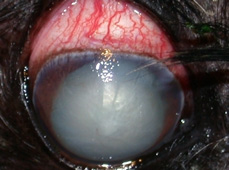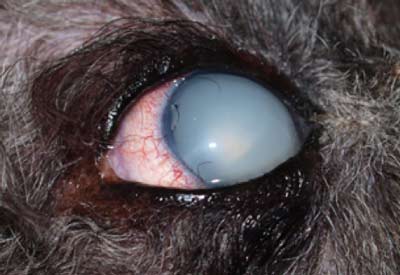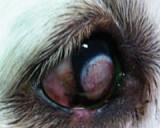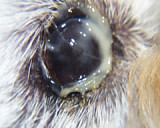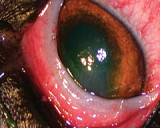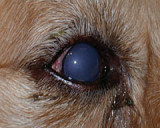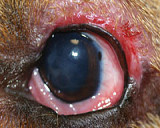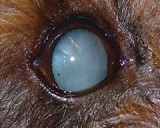Cataracts may occur due to a variety of causes such as genetic, diabetes, PRA and age.
The ideal treatment for cataracts is surgical removal via phacofragmentation. This however may not be an option due to various reasons such as medical, financial or old age. Furthermore, cataracts secondary to retinal degeneration such as PRA are not removed. In these cases, medical management will be required.
Lens-induced uveitis (LIU)
All cataracts generate a degree of lens-induced uveitis (LIU). The change in lens protein that occurs as a cataract develops appears to make it more susceptible to leakage out of the lens capsule and this incites an inflammatory reaction. Where a cataract progresses rapidly, for example with diabetes, LIU seems to be more severe. LIU needs to be treated in order to prevent painful sequelae such as lens luxation and glaucoma. The treatment for these conditions is generally eye removal or intrascleral prosthesis as topical glaucoma medications do not have good efficacy in the long term.
early cataract 010
Management
LIU is managed mostly by topical corticosteroids (Prednefrin Forte® and Maxidex® eye drops) or topical NSAIDs (Voltaren® eye drops). Initially the drops are used BID to TID as required to get the perilimbal hyperaemia to resolve, then SID long term. Some dogs will be able to be reduced to every other day therapy. Owners must be educated to monitor for the signs of corneal ulceration: to stop the drops if the eye is suddenly sore, closed, watery, mucky, or blue or red in a different way and contact you ASAP.
Cortisone won’t cause an ulcer, however if the dog or cat scratches the eye, the cortisone will delay healing and create an environment that predisposes to infection.
Diabetics
All diabetics will develop cataracts. Owners should be warned at the time of diagnosis to monitor for cloudiness. 50% of diabetics develop cataract by 12 months and 80% by 16months of diagnosis. This knowledge can help the owners make an informed decision about whether or not to treat the diabetes. If the owners are interested in cataract surgery, early referral prior to development of cataracts is ideal to educate the owners about what to look for. It also allows us to check the retina whilst visible. There is often a concern that topical steroids will destabilise diabetics however this is rarely an issue. Our clients have sometimes commented that insulin requirements increase at the time of blindness, presumably due to stress. After surgery, when vision has been returned, insulin requirements may reduce. We are happy to say that diabetics tend to have our best success rates following cataract surgery.
PB291914
Nutritional supplement
A new development is a nutritional supplement called ‘Ocuglo’ which can be used to slow the progression of active but small cataracts. In vitro data suggests that this may delay progression and decrease the LIU seen with actively progressing cataracts. We have started using this product in dogs with PRA who still have some useful vision but are losing it due to cataract development. This product may delay the progression of the cataract sufficiently for them to retain useful vision until complete retinal atrophy occurs.
Future
In the future other medications may be developed that delay or stop cataract development. Various trials have been published on a topical aldose reductase inhibitor that has shown to be very effective in controlling the development of diabetic cataracts. This may well reach the market place soon, but the downside is the strict three times daily dosing regime required to be effective. This would be an ongoing medication.
We appreciate that some patients with cataracts may not be surgical candidates. It is important to manage LIU to minimise complications that may arise.



